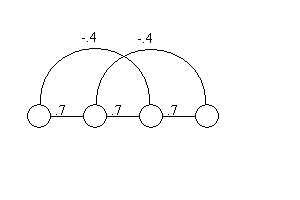Initial Answer
- Hopfield provides a simple solution with Hopfield nets. There are
a host of solutions, but 4 stable states with 4 neurons can show
one.
| 1 | 2 | 3 | 4 |
| 1 | | 0.7 | -0.4 | 0.7 |
| 2 | | | 0.7 | -0.4 |
| 3 | | | | 0.7 |
Threshold = 0.5- If 1 and 2 are on, they'll stay on and suppress 3 and 4.
- Anything that is on will stay on.
- This can be expanded to 10 (turn on those adjacent, inhibit those
two away, and ignore the rest.
- This can then be run with the CA simulator CANT.
- Turn off learning, turn off fatigue, turn off decay (set it 20),
and ignore Gray's rule
- Make two unidirectional connections instead of one.
- Combine as many 10 long nets as you like (try a 20x20).
- It maintains 10 stable states each with neurons that participate
in 2 stable states.
- Problem, no completion (set input stimuli to 60)
- Problem, can not deal with noise (try spontaneous activation).




